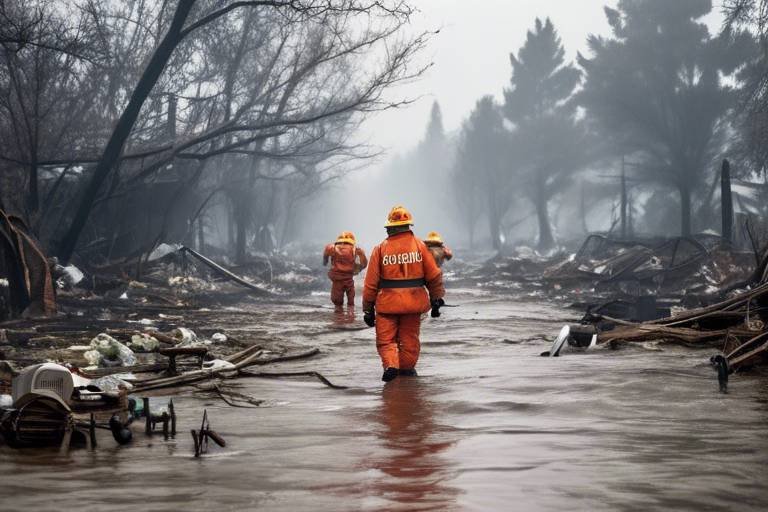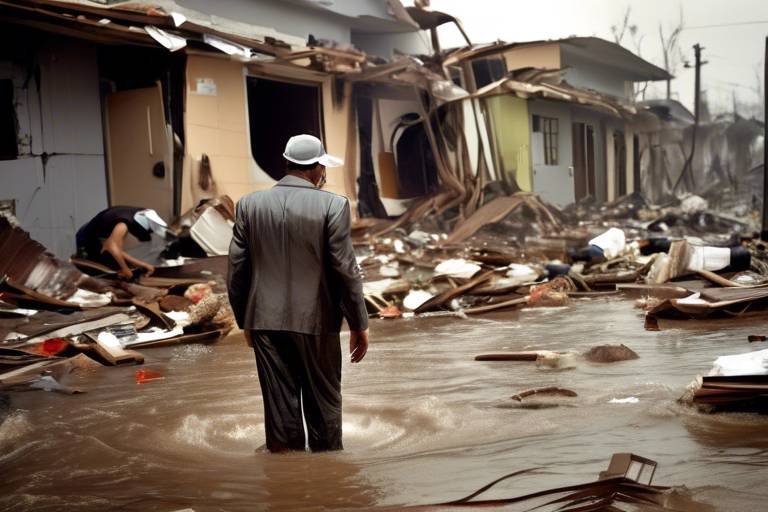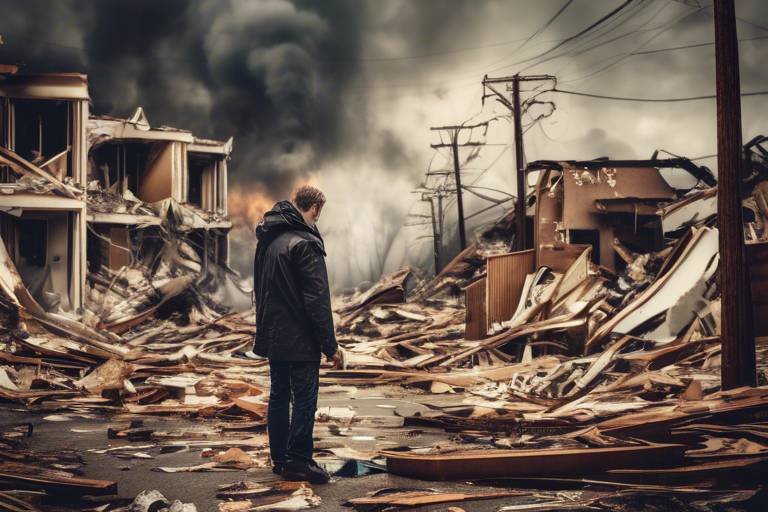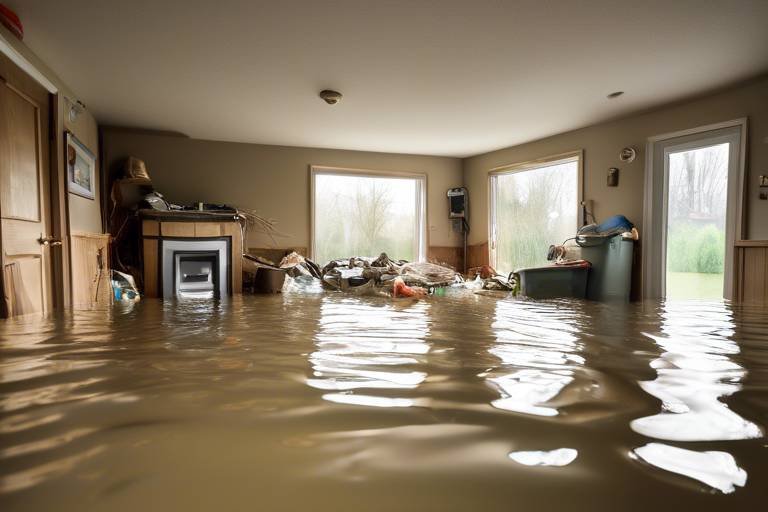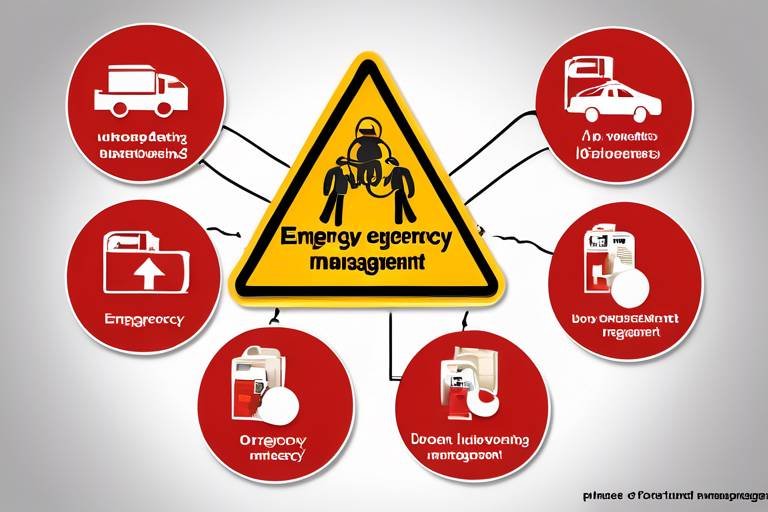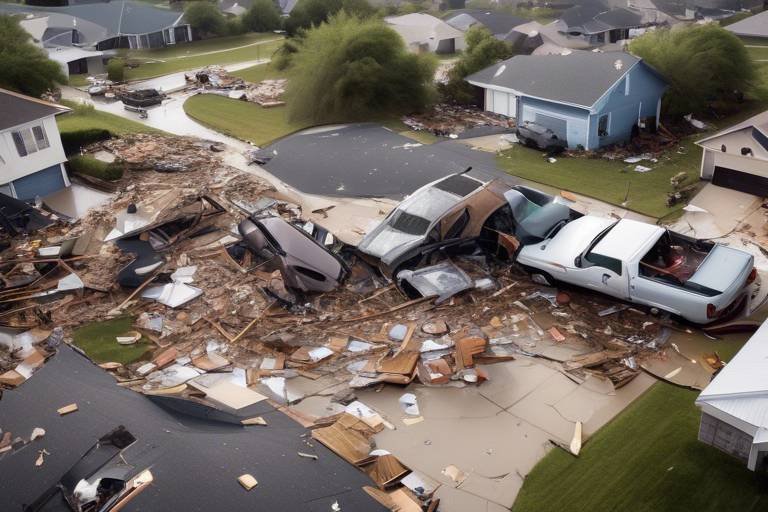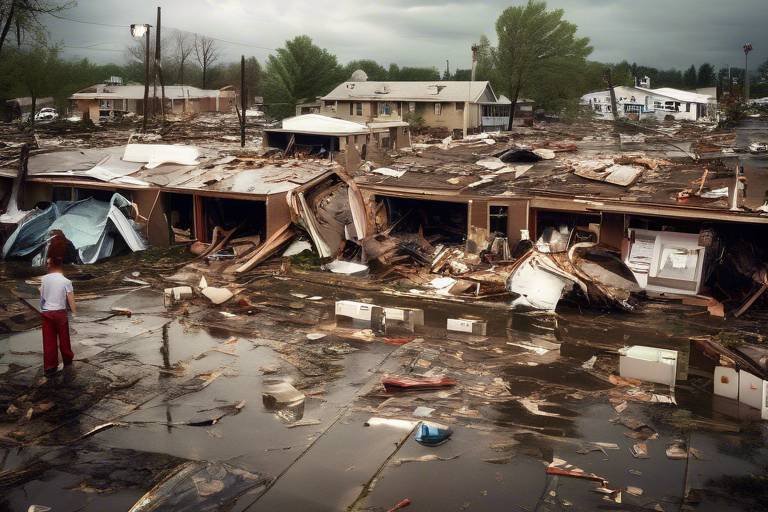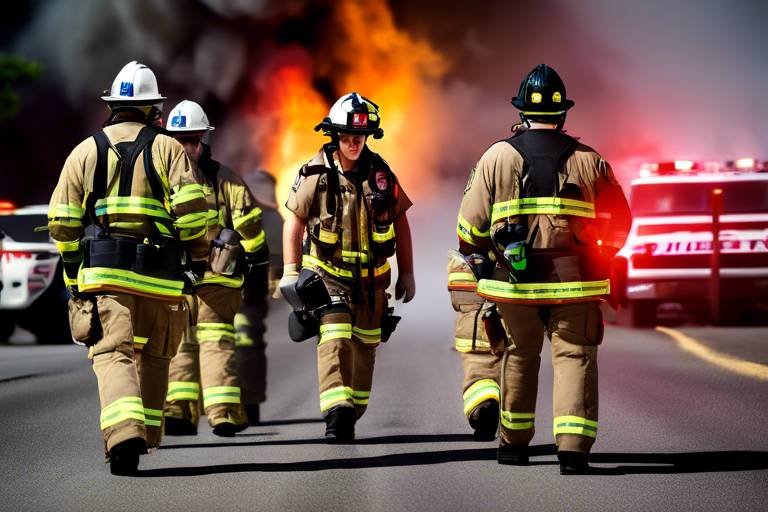Understand the Impact of Climate Change on Emergency Preparedness
Climate change is no longer a distant threat; it's a pressing reality that is reshaping our world in profound ways. As temperatures rise and extreme weather events become more frequent, the impact on emergency preparedness is undeniable. Communities are facing challenges that require not only immediate responses but also long-term adaptations to ensure safety and resilience. But what does this mean for how we prepare for emergencies? Are our current strategies sufficient to tackle the increasing environmental threats posed by climate change? Let's dive into the science behind climate change and explore how it affects our ability to respond effectively in times of crisis.
Understanding the fundamental science behind climate change is crucial for recognizing its implications on emergency preparedness. Climate change refers to significant alterations in temperature, precipitation patterns, and other atmospheric conditions over extended periods. The primary drivers of climate change include greenhouse gas emissions from human activities, deforestation, and industrial processes. These factors lead to rising global temperatures, melting ice caps, and shifting weather patterns, which in turn result in more severe and frequent natural disasters.
For instance, consider the increase in the intensity of hurricanes and storms. As ocean temperatures rise, so do the energy levels of these storms, leading to devastating impacts on coastal communities. Flooding, wildfires, and droughts are becoming more common, creating a pressing need for emergency preparedness frameworks that can withstand these challenges.
To effectively tackle the challenges posed by climate change, emergency preparedness frameworks must evolve. Traditional approaches often fall short in addressing the complexities of climate-related disasters. An effective framework should not only include response strategies but also encompass prevention, mitigation, and recovery efforts. This holistic approach ensures that communities are better equipped to respond to increasingly frequent and severe disasters.
One of the cornerstones of effective emergency preparedness is robust risk assessment strategies. Identifying vulnerabilities within communities allows for targeted preparedness measures that can mitigate the effects of climate-related disasters. For instance, areas prone to flooding can benefit from improved drainage systems and better land-use planning, while regions susceptible to wildfires may need enhanced firebreaks and community awareness programs.
Accurate data collection and analysis play a vital role in understanding climate impacts. Emergency planners need to make informed decisions based on current and projected environmental changes. By utilizing advanced technologies such as geographic information systems (GIS) and climate modeling, communities can better anticipate risks and prepare accordingly. For example, real-time data on weather patterns can help in making timely decisions during emergencies, potentially saving lives and resources.
Engaging communities in the risk assessment process fosters resilience. When individuals understand the risks they face, they are more likely to contribute to preparedness efforts. This can be achieved through community workshops, educational campaigns, and participatory planning sessions. By addressing local needs and concerns, we can create a culture of preparedness that empowers everyone to take action.
Adaptation strategies are critical in enhancing community resilience. This involves not only improving infrastructure but also focusing on resource management and public education. For instance, communities can invest in green infrastructure, such as rain gardens and permeable pavements, to manage stormwater effectively. Additionally, public education campaigns can equip residents with knowledge about emergency procedures and resources available during a disaster.
Examining case studies of past climate-related disasters provides valuable insights into the effectiveness of emergency preparedness measures. For example, the response to Hurricane Katrina in 2005 highlighted the importance of timely communication and resource allocation. Lessons learned from such events can inform future planning and improve coordination among agencies during crises.
Analyzing recent climate events reveals common challenges faced by emergency responders. For instance, the wildfires in California have demonstrated the need for better inter-agency collaboration and communication strategies. By refining these approaches, we can enhance our readiness and response capabilities for future emergencies.
Identifying innovative solutions and best practices from various regions can inspire communities to adopt successful approaches to emergency preparedness. For example, cities that have implemented early warning systems for floods have seen significant reductions in disaster impacts. By sharing these success stories, we can encourage other communities to tailor their preparedness strategies to their specific climate vulnerabilities.
Effective policies are essential for enhancing emergency preparedness in the context of climate change. Policymakers must guide resource allocation and foster collaboration among government agencies, NGOs, and communities. This collaborative approach is vital for creating comprehensive strategies that address the multifaceted impacts of climate change.
Securing adequate funding and resources is vital for implementing effective emergency preparedness initiatives. Governments must prioritize investments in infrastructure, training, and community engagement to ensure that communities have the tools necessary to respond to climate-induced challenges.
Collaboration between various sectors, including government, private, and non-profit organizations, is crucial for developing comprehensive emergency preparedness strategies. By working together, these entities can share knowledge, resources, and best practices to create a more resilient society.
- What are the main effects of climate change on emergency preparedness? Climate change leads to increased frequency and severity of natural disasters, requiring updated emergency response strategies.
- How can communities improve their emergency preparedness? By engaging in risk assessment, investing in infrastructure, and fostering community education and involvement.
- What role does data play in emergency preparedness? Accurate data collection and analysis help planners make informed decisions and anticipate risks effectively.

The Science of Climate Change
This article explores how climate change affects emergency preparedness, examining the challenges and adaptations necessary for effective response strategies in the face of increasing environmental threats.
Understanding the fundamental science behind climate change is crucial for recognizing its implications on emergency preparedness. At its core, climate change refers to significant alterations in temperature, precipitation patterns, and other atmospheric conditions over extended periods. These changes are primarily driven by human activities, especially the burning of fossil fuels, deforestation, and industrial processes, which increase the concentration of greenhouse gases in the atmosphere. This phenomenon leads to a variety of environmental impacts that can drastically affect communities worldwide.
One of the most alarming consequences of climate change is the rise in global temperatures. According to the Intergovernmental Panel on Climate Change (IPCC), the Earth's average surface temperature has increased by about 1.1 degrees Celsius since the late 19th century. This seemingly small change has profound implications, contributing to more frequent and severe weather events, such as hurricanes, floods, and droughts. The increasing intensity of these events poses significant challenges for emergency preparedness and response efforts.
Moreover, extreme weather events are not the only concern. Climate change also leads to gradual changes that can disrupt ecosystems and human livelihoods. For instance, rising sea levels threaten coastal communities with flooding, while prolonged droughts can lead to water shortages and food insecurity. These shifts require a comprehensive understanding of their potential impacts on communities, necessitating a proactive approach to emergency preparedness.
In order to effectively prepare for these challenges, it is essential to consider various factors:
- Increased Frequency of Natural Disasters: As the climate warms, the frequency and severity of natural disasters are on the rise.
- Health Risks: Climate change can exacerbate health issues, leading to increased hospitalizations and strain on healthcare systems.
- Economic Impacts: The costs associated with climate-related disasters can be staggering, affecting local economies and livelihoods.
To illustrate the impact of climate change on emergency preparedness, consider the following table that summarizes the types of extreme weather events and their projected changes:
| Weather Event | Current Frequency | Projected Increase by 2050 |
|---|---|---|
| Hurricanes | More than 90 per year | Up to 30% increase |
| Droughts | 20% of global land area | 50% increase in affected areas |
| Floods | Over 200 million people affected annually | Potential doubling of affected population |
This data underscores the need for emergency preparedness frameworks to adapt and evolve in response to the changing climate. By understanding the science of climate change, communities can develop strategies that not only address immediate concerns but also build long-term resilience against future environmental threats.
Effective emergency preparedness frameworks must evolve to address the challenges posed by climate change, ensuring that communities are equipped to respond to increasingly frequent and severe disasters.
Implementing robust risk assessment strategies is essential for identifying vulnerabilities in communities, allowing for targeted preparedness measures that can mitigate the effects of climate-related disasters.
Accurate data collection and analysis play a vital role in understanding climate impacts, enabling emergency planners to make informed decisions based on current and projected environmental changes.
Engaging communities in risk assessment processes fosters resilience, empowering individuals to contribute to preparedness efforts and ensuring that local needs and concerns are addressed effectively.
Adaptation strategies are critical in enhancing community resilience, focusing on infrastructure improvements, resource management, and public education to better prepare for climate-related emergencies.
Examining case studies of past climate-related disasters provides valuable insights into the effectiveness of emergency preparedness measures and highlights lessons learned for future planning.
Analyzing recent climate events reveals common challenges faced by emergency responders, offering opportunities for refining strategies and improving coordination among agencies during crises.
Identifying innovative solutions and best practices from various regions can inspire communities to adopt successful approaches to emergency preparedness, tailored to their specific climate vulnerabilities.
Effective policies are essential for enhancing emergency preparedness in the context of climate change, guiding resource allocation, and fostering collaboration among government agencies, NGOs, and communities.
Securing adequate funding and resources is vital for implementing effective emergency preparedness initiatives, ensuring that communities have the tools necessary to respond to climate-induced challenges.
Collaboration between various sectors, including government, private, and non-profit organizations, is crucial for developing comprehensive emergency preparedness strategies that address the multifaceted impacts of climate change.
Q: What is climate change?
A: Climate change refers to significant changes in global temperatures and weather patterns over time, primarily driven by human activities.
Q: How does climate change affect emergency preparedness?
A: Climate change increases the frequency and severity of natural disasters, necessitating updates to emergency preparedness strategies.
Q: What can communities do to prepare for climate-related emergencies?
A: Communities can engage in risk assessments, improve infrastructure, and foster public education to enhance resilience against climate threats.

Emergency Preparedness Frameworks
In our rapidly changing world, the need for effective has never been more critical. As climate change intensifies, communities are facing unprecedented challenges that require not only a shift in mindset but also a comprehensive overhaul of existing strategies. Think of emergency preparedness as a sturdy umbrella; without it, you might find yourself drenched when the storm hits. The frameworks we establish today will determine how well we weather the storms of tomorrow.
To build resilient communities, frameworks must be adaptable, incorporating the latest scientific research and data on climate impacts. This means moving away from one-size-fits-all approaches and instead tailoring strategies to meet the unique needs of each locality. For instance, coastal towns may prioritize flood defenses, while inland areas might focus on wildfire management. The key is to recognize that climate change is not a distant threat; it is here, and it is affecting us now.
Effective frameworks should include several essential components:
- Risk Assessment: Understanding the specific vulnerabilities of a community is crucial. This involves identifying which areas are most at risk from climate-related disasters and what resources are available to mitigate those risks.
- Resource Allocation: Allocating resources effectively ensures that the most vulnerable populations are prioritized. This includes not only financial resources but also human capital—trained personnel who can lead emergency responses.
- Public Education: Educating the community about potential risks and response strategies fosters a culture of preparedness. When people know what to do in an emergency, they are more likely to respond effectively.
Moreover, these frameworks must be dynamic. They should be regularly updated based on new data and lessons learned from previous emergencies. For example, after a major flood, it is essential to analyze what worked and what didn’t, adjusting the framework accordingly. This iterative process is akin to fine-tuning a recipe—sometimes a pinch more salt or a dash less spice is all it takes to make it just right.
Collaboration plays a vital role in the success of emergency preparedness frameworks. Engaging various stakeholders—from local governments and non-profits to community members—creates a more comprehensive plan. Each group brings unique insights and resources to the table, making the framework more robust. Think of it as a potluck dinner; everyone contributes their best dish, resulting in a feast that no single person could have prepared alone.
In conclusion, as we face the growing challenges posed by climate change, it is imperative that we develop and refine our emergency preparedness frameworks. By focusing on adaptability, collaboration, and continuous improvement, we can ensure that our communities are not just prepared for the storms ahead, but are also resilient in the face of adversity.
Q1: What is an emergency preparedness framework?
An emergency preparedness framework is a structured approach that outlines how communities can prepare for, respond to, and recover from emergencies, particularly those related to climate change.
Q2: Why is climate change a factor in emergency preparedness?
Climate change leads to more frequent and severe weather events, such as hurricanes, floods, and wildfires, necessitating updated and effective preparedness strategies to protect communities.
Q3: How can communities improve their emergency preparedness?
Communities can improve preparedness by conducting risk assessments, engaging in public education, collaborating with various stakeholders, and continuously updating their response strategies based on new information.

Risk Assessment Strategies
When it comes to navigating the turbulent waters of climate change, serve as the compass guiding communities toward effective emergency preparedness. These strategies are not just about identifying potential threats; they involve a comprehensive understanding of the vulnerabilities specific to each community. Imagine trying to navigate a stormy sea without knowing where the rocks are—this is what communities face without robust risk assessment. By pinpointing areas of weakness, emergency planners can tailor their approaches to fit the unique needs of their populations.
One of the key elements in effective risk assessment is the use of data collection and analysis. This involves gathering information on various factors, such as historical weather patterns, demographic data, and existing infrastructure. For instance, communities in coastal areas might focus on flooding risks, while those in arid regions may prioritize wildfire threats. By analyzing this data, planners can forecast potential disasters and develop targeted strategies to mitigate their impacts. The importance of this process cannot be overstated; it’s akin to a doctor diagnosing a patient before prescribing treatment. Without the right diagnosis, the treatment plan may be ineffective or even harmful.
Furthermore, community engagement plays a pivotal role in enhancing these risk assessment strategies. When local residents are involved in the process, it not only fosters a sense of ownership but also ensures that the strategies developed are relevant and effective. People on the ground often have insights that data alone cannot provide. For example, they may know of areas prone to flooding that are not officially recognized in maps or databases. By incorporating community feedback, emergency planners can create a more accurate picture of risks and vulnerabilities.
In addition to local knowledge, leveraging technology can significantly enhance risk assessment efforts. Tools such as Geographic Information Systems (GIS) allow planners to visualize data spatially, making it easier to identify high-risk areas and allocate resources effectively. For example, a GIS analysis might reveal that certain neighborhoods are disproportionately affected by heat waves, prompting targeted interventions like public cooling centers or outreach programs to vulnerable populations.
Moreover, it’s essential to regularly update risk assessments to reflect ongoing changes in climate patterns and community dynamics. As the climate continues to evolve, so do the risks associated with it. This means that what worked yesterday may not be effective tomorrow. Therefore, a continuous feedback loop—where data is regularly collected, analyzed, and acted upon—is crucial for maintaining effective emergency preparedness.
In summary, effective risk assessment strategies are the backbone of any emergency preparedness plan. They require a combination of data analysis, community engagement, and technological tools to create a comprehensive understanding of vulnerabilities. By prioritizing these strategies, communities can not only prepare for potential disasters but also enhance their overall resilience in the face of climate change.
- What is risk assessment in the context of climate change?
Risk assessment involves identifying and analyzing potential threats posed by climate change to develop effective emergency preparedness strategies. - How can community engagement improve risk assessment?
Community engagement ensures that local knowledge is incorporated into risk assessments, making them more relevant and effective. - Why is data collection important for risk assessment?
Accurate data helps planners understand historical trends and forecast potential disasters, allowing for targeted preparedness measures. - How often should risk assessments be updated?
Risk assessments should be updated regularly to reflect ongoing changes in climate patterns and community dynamics.

Data Collection and Analysis
Effective data collection and analysis are the backbone of any successful emergency preparedness strategy, especially in the context of climate change. Imagine trying to navigate a stormy sea without knowing the weather forecast—this is what communities face without accurate data. By systematically gathering and analyzing relevant information, emergency planners can better understand the specific climate threats their regions face. This understanding is not just about knowing that storms are getting stronger; it involves delving into patterns, trends, and potential future scenarios that could impact local populations and infrastructure.
Data collection encompasses a variety of methods, from satellite imagery and weather stations to community surveys and historical records. Each of these sources contributes to a comprehensive picture of how climate change is affecting the environment. For instance, satellite data can reveal shifts in land use, while local surveys can provide insights into community perceptions and preparedness levels. The combination of quantitative and qualitative data allows for a nuanced understanding of vulnerabilities and risks.
Moreover, data analysis involves interpreting this information to draw actionable conclusions. This can include:
- Identifying Vulnerable Areas: By analyzing data on past disasters, planners can pinpoint which neighborhoods are most at risk.
- Predicting Future Trends: Climate models can help forecast how rising temperatures or increased rainfall might affect specific regions.
- Assessing Resource Needs: Understanding the data allows for better allocation of resources, ensuring that the most vulnerable populations receive the support they need.
Furthermore, the importance of real-time data cannot be overstated. In emergencies, timely information can make the difference between life and death. For instance, during a flood, having access to real-time water level data can help emergency responders make swift decisions about evacuations and resource deployment. This highlights the need for robust data systems that can provide up-to-date information during crises.
In addition to technical data, community feedback plays a crucial role in the data collection process. Engaging local residents in discussions about their experiences and concerns can reveal gaps in preparedness and areas needing improvement. This participatory approach not only enriches the data but also fosters a sense of ownership and responsibility among community members, making them more likely to engage in preparedness efforts.
In summary, the integration of comprehensive data collection and thorough analysis is essential for enhancing emergency preparedness in the face of climate change. By harnessing both technical data and community input, planners can develop strategies that are not only effective but also tailored to the unique needs of their populations. This proactive approach enables communities to face climate-related challenges with confidence, ultimately leading to greater resilience and safety.
- What types of data are most important for emergency preparedness? Data on local climate patterns, historical disaster impacts, infrastructure vulnerabilities, and community demographics are crucial.
- How can communities contribute to data collection? Communities can engage in surveys, provide historical accounts of previous disasters, and participate in local planning meetings.
- Why is real-time data so important during emergencies? Real-time data allows for quick decision-making, which can help save lives and resources during crises.

Community Engagement
Engaging communities in the emergency preparedness process is not just beneficial; it’s absolutely essential. When local residents are actively involved, they become more informed and invested in the strategies that are designed to protect them. Imagine a neighborhood where everyone understands the risks of climate change and knows exactly what to do when disaster strikes. This level of awareness can significantly reduce panic during emergencies and enhance the overall effectiveness of response efforts.
One of the key aspects of community engagement is fostering a sense of ownership among residents. When individuals feel that they have a stake in their safety, they are more likely to participate in preparedness activities. This can include attending workshops, participating in drills, or even organizing community meetings to discuss local vulnerabilities. For instance, a town might hold a series of informational sessions where residents can learn about potential flood risks and how to create an emergency plan tailored to their specific circumstances.
Moreover, community engagement allows emergency planners to tap into local knowledge and resources. Residents often have insights into the unique challenges their neighborhoods face, which can be invaluable in shaping effective preparedness strategies. By encouraging open dialogue, emergency management agencies can better address local needs and concerns. For example, if a community identifies that many residents rely on public transportation, planners can prioritize accessible evacuation routes and communication methods that reach those individuals.
To facilitate this engagement, various methods can be employed, such as:
- Workshops and Training Sessions: These provide hands-on experience and education about emergency preparedness.
- Community Surveys: Gathering feedback from residents helps identify specific concerns and priorities.
- Social Media Campaigns: Utilizing platforms like Facebook and Twitter can raise awareness and encourage participation in preparedness initiatives.
Ultimately, the goal of community engagement is to build resilience. When people are connected, informed, and prepared, they can respond more effectively to climate-related emergencies. This not only saves lives but also fosters a stronger, more cohesive community. As we face the ever-growing challenges of climate change, let’s remember that the most powerful resource we have is our community. Together, we can create a safer and more prepared environment for everyone.
Q: Why is community engagement important in emergency preparedness?
A: Community engagement is crucial because it empowers residents, enhances awareness, and ensures that local needs are addressed in preparedness strategies.
Q: How can communities get involved in emergency preparedness?
A: Communities can participate through workshops, training sessions, surveys, and social media campaigns that promote awareness and preparedness activities.
Q: What role do local insights play in emergency planning?
A: Local insights help emergency planners understand specific vulnerabilities and challenges, allowing for tailored strategies that effectively address community needs.

Adaptation and Resilience Planning
When we talk about , we're diving into a crucial aspect of emergency preparedness that recognizes the reality of climate change. It's not just about reacting to disasters; it's about proactively enhancing our ability to withstand them. Think of it like upgrading your home’s security system. You wouldn’t wait for a break-in to install alarms or cameras, right? Similarly, communities need to implement strategies that bolster their defenses against the unpredictable nature of climate-related events.
One of the primary focuses of adaptation planning is on infrastructure improvements. For instance, cities might invest in flood defenses, such as levees or improved drainage systems, to combat the increasing severity of storms and rising sea levels. This isn't just a band-aid solution; it's about creating a robust framework that can absorb the shocks of climate impacts. Moreover, communities must also consider the management of natural resources. Sustainable practices in water management, agriculture, and energy use can significantly mitigate the adverse effects of climate change.
Public education plays a vital role in this equation. Imagine a neighborhood where everyone is aware of the risks they face and knows exactly what to do when disaster strikes. This kind of awareness can save lives and reduce panic during emergencies. Therefore, community workshops and training sessions should be organized regularly, ensuring that residents are not only informed but also engaged in the planning process. This participatory approach fosters a sense of ownership and accountability among community members, making them more resilient.
Moreover, adaptation strategies should be tailored to the unique vulnerabilities of each community. For example, coastal towns might prioritize sea wall construction, while inland areas may focus on wildfire prevention strategies. It's essential to conduct thorough risk assessments to identify these specific needs. A well-informed community is a prepared community, and understanding local risks is the first step in crafting effective resilience strategies.
In conclusion, adaptation and resilience planning is about building a culture of preparedness that embraces change rather than fears it. By investing in infrastructure, engaging the community, and tailoring strategies to local needs, we can create a future where we are not just surviving climate impacts but thriving in spite of them. The path ahead may be challenging, but with the right planning and a united effort, we can navigate the stormy seas of climate change together.
- What is adaptation planning? Adaptation planning involves developing strategies to prepare for and manage the impacts of climate change on communities and ecosystems.
- Why is community engagement important? Community engagement ensures that local needs and concerns are addressed, fostering resilience and a sense of ownership in preparedness efforts.
- How can infrastructure improvements help? Upgrading infrastructure like flood defenses and drainage systems can significantly reduce the risk of damage during extreme weather events.
- What role does education play in resilience planning? Public education raises awareness about climate risks and prepares individuals to respond effectively during emergencies.

Case Studies of Climate-Related Disasters
When we think about the impact of climate change, it's easy to get lost in statistics and scientific jargon. However, the reality hits home when we examine real-life case studies of climate-related disasters. These stories not only illustrate the severity of the situation but also provide valuable lessons that can guide future emergency preparedness efforts. For instance, let's take a closer look at the devastating effects of Hurricane Katrina in 2005 and the California wildfires that have increasingly ravaged the state over the past decade.
Hurricane Katrina, one of the deadliest hurricanes in U.S. history, exposed significant flaws in emergency response systems. The storm made landfall in New Orleans, Louisiana, leading to catastrophic flooding and the loss of over 1,800 lives. The aftermath revealed a shocking lack of coordination among local, state, and federal agencies, which resulted in delayed responses and inadequate support for affected communities. This disaster highlighted the importance of having a well-structured emergency preparedness framework that can adapt to the challenges posed by climate change. It also emphasized the need for effective communication strategies to keep citizens informed during crises.
On the other hand, the California wildfires have become an annual occurrence, escalating in both frequency and intensity. In 2020 alone, over 4 million acres were burned, displacing thousands and causing billions in damages. These fires serve as a stark reminder of how climate change is altering our landscapes and increasing the risks of natural disasters. One of the key takeaways from these wildfires is the significance of community engagement in preparedness efforts. Local residents are often the first responders in such situations, and their knowledge of the area can be invaluable. Engaging communities in risk assessment and planning can lead to more effective strategies that cater to specific local vulnerabilities.
To further illustrate the impact of these disasters, let's look at a table that summarizes the key lessons learned from both Hurricane Katrina and the California wildfires:
| Disaster | Key Lessons Learned |
|---|---|
| Hurricane Katrina |
|
| California Wildfires |
|
These case studies serve as a wake-up call, emphasizing that climate change is not just a distant threat but a reality that communities face today. By analyzing past events, we can identify common challenges and refine our emergency preparedness strategies to better handle future disasters. It’s not just about having a plan; it’s about having a plan that works and is adaptable to the ever-changing climate landscape.
Q: What are some common challenges faced during climate-related disasters?
A: Common challenges include inadequate communication, lack of coordination among agencies, and insufficient resources for effective response.
Q: How can communities better prepare for climate-related emergencies?
A: Communities can engage in risk assessment processes, participate in preparedness training, and develop local response plans that address specific vulnerabilities.
Q: Why is data collection important in emergency preparedness?
A: Accurate data collection helps emergency planners understand climate impacts, enabling informed decision-making and effective resource allocation.

Lessons from Recent Events
Recent climate events have served as a stark reminder of the urgent need for effective emergency preparedness. From devastating hurricanes to unprecedented wildfires, these incidents have exposed vulnerabilities in our response systems and highlighted the importance of learning from past mistakes. For instance, the aftermath of Hurricane Katrina in 2005 taught us that inadequate communication and coordination among agencies can lead to catastrophic outcomes. It emphasized the necessity of having a well-defined chain of command and clear communication channels during emergencies.
Similarly, the wildfires that swept through California in recent years revealed the critical need for proactive measures in fire-prone areas. Communities that had invested in firebreaks and other mitigation strategies found themselves better equipped to handle the flames. This underscores a vital lesson: preparation is key. It’s not just about having a plan; it’s about continually updating that plan based on the latest data and trends in climate science.
Moreover, we’ve seen how social media can be a double-edged sword during emergencies. On one hand, it serves as a powerful tool for disseminating information quickly; on the other, misinformation can spread just as fast, creating panic and confusion. The experience from recent disasters has shown that emergency management agencies must harness the power of social media effectively, using it to communicate accurate information while also combating false narratives.
In addition to these lessons, community engagement has emerged as a cornerstone of successful emergency preparedness. When individuals feel empowered and informed about potential risks, they are more likely to take action. For example, neighborhoods that organized community meetings to discuss emergency plans and resources reported a higher level of preparedness among residents. This highlights the importance of collaborative efforts in fostering resilience.
To illustrate these lessons further, let’s take a look at a table summarizing key takeaways from recent climate-related disasters:
| Event | Key Lesson | Recommended Action |
|---|---|---|
| Hurricane Katrina | Need for clear communication | Establish a unified command structure |
| California Wildfires | Importance of proactive measures | Invest in mitigation strategies |
| Texas Winter Storm | Vulnerability of infrastructure | Upgrade energy systems for resilience |
| COVID-19 Pandemic | Role of misinformation | Utilize social media for accurate information |
In conclusion, the lessons learned from recent climate-related events serve as a guiding light for future emergency preparedness efforts. By acknowledging our shortcomings and actively working to address them, we can build a more resilient society ready to face the challenges that climate change presents. It’s about turning these lessons into actionable strategies that not only protect lives but also foster a culture of preparedness within our communities.
- What are the primary factors contributing to climate change? Climate change is primarily driven by human activities, including the burning of fossil fuels, deforestation, and industrial processes that increase greenhouse gas emissions.
- How can communities better prepare for climate-related disasters? Communities can enhance their preparedness by conducting risk assessments, investing in infrastructure improvements, and engaging residents in emergency planning.
- What role does technology play in emergency preparedness? Technology aids in data collection, real-time communication, and resource management, enabling more effective responses during emergencies.

Innovative Solutions and Best Practices
As climate change continues to challenge our emergency preparedness frameworks, it's essential to explore innovative solutions and best practices that have emerged in various communities. These strategies not only enhance resilience but also empower local populations to effectively respond to climate-related threats. One of the most promising approaches is the integration of technology into emergency management systems. For instance, utilizing geographic information systems (GIS) allows planners to visualize risk areas, helping them to allocate resources more efficiently and effectively.
Moreover, communities are increasingly turning to community-driven initiatives that foster local engagement. By involving residents in the planning process, communities can create tailored emergency response plans that reflect their unique vulnerabilities and strengths. This participatory approach not only builds trust but also ensures that the plans are more relevant and actionable. For example, in coastal areas prone to flooding, local groups have developed neighborhood watch systems that include training sessions on emergency response and evacuation procedures.
Another innovative solution is the use of green infrastructure to mitigate the impacts of extreme weather. By implementing features such as rain gardens, green roofs, and permeable pavements, cities can reduce runoff and improve water management during heavy rainfall events. This not only helps in managing immediate flood risks but also contributes to long-term environmental sustainability. In fact, a study conducted in New York City showed that areas with green infrastructure experienced significantly less flooding compared to those without.
Furthermore, the adoption of mobile applications for emergency alerts and information dissemination is revolutionizing how communities prepare for and respond to disasters. These apps can provide real-time updates on weather conditions, evacuation routes, and safety tips, making it easier for individuals to stay informed and act quickly. For instance, during the recent hurricane season, many regions utilized such apps to keep residents updated, which significantly improved response times and reduced chaos during evacuations.
To ensure these innovative practices are effectively implemented, it's crucial to invest in training and capacity building. Emergency responders and community members alike need access to ongoing education and resources to adapt to the evolving challenges posed by climate change. This could include workshops, simulations, and collaborative exercises that not only enhance skills but also foster a culture of preparedness.
In conclusion, the integration of technology, community engagement, green infrastructure, and mobile solutions are just a few examples of how innovative practices can enhance emergency preparedness in the face of climate change. As we learn from these initiatives, it's vital to share these best practices across regions to build a more resilient future for all communities.
- What are some examples of innovative solutions for emergency preparedness? Innovative solutions include the use of GIS for risk assessment, community-driven initiatives, green infrastructure, and mobile applications for real-time alerts.
- How can communities engage in emergency preparedness planning? Communities can participate by joining local planning committees, attending workshops, and contributing their unique insights and needs to the planning processes.
- Why is training important for emergency responders? Training ensures that responders are equipped with the necessary skills and knowledge to effectively manage emergencies, especially as climate-related challenges evolve.

Policy Implications and Recommendations
As the challenges posed by climate change become more pronounced, it is essential to recognize the policy implications that emerge in the realm of emergency preparedness. Effective policies are the backbone of a robust emergency response framework, guiding how resources are allocated and how different entities collaborate to tackle climate-related challenges. Without a solid policy foundation, communities may find themselves ill-equipped to respond to increasingly severe environmental threats.
One of the most pressing needs is for funding and resource allocation. Securing adequate financial support is vital for implementing initiatives that enhance emergency preparedness. This funding can be directed toward improving infrastructure, developing early warning systems, and conducting training programs for emergency responders. For instance, communities can benefit from investment in better flood defenses or wildfire management systems that are crucial as climate patterns shift. The table below illustrates potential funding sources and their intended uses:
| Funding Source | Intended Use |
|---|---|
| Federal Grants | Infrastructure improvements and disaster response training |
| State Emergency Funds | Local preparedness initiatives and community outreach programs |
| NGO Partnerships | Resource management and public education campaigns |
Moreover, collaboration across various sectors is paramount. The intersection of government, private organizations, and non-profits can foster a comprehensive approach to emergency preparedness. When these entities work together, they can create a unified strategy that not only addresses immediate needs but also anticipates future challenges. For example, a partnership between local governments and tech companies can lead to the development of innovative solutions, such as mobile apps that provide real-time alerts during emergencies.
However, effective collaboration requires clear communication and shared goals. It’s not just about coming together; it’s about ensuring that everyone is on the same page. Regular meetings, joint training exercises, and shared resources can help build trust and streamline response efforts. This approach not only enhances preparedness but also cultivates a sense of community resilience. After all, when people feel connected and informed, they are more likely to take proactive steps to protect themselves and their neighbors.
In addition to these strategies, it is crucial to involve local communities in the policy-making process. Engaging residents in discussions about their specific vulnerabilities and needs can lead to more effective and tailored emergency preparedness plans. This grassroots approach ensures that policies are not just top-down mandates but are informed by the lived experiences of those most affected by climate change. Engaging communities can take many forms, including public forums, surveys, and workshops, where individuals can voice their concerns and contribute to the planning process.
In summary, the implications of climate change on emergency preparedness demand a multifaceted policy response. By focusing on funding, fostering collaboration across sectors, and engaging communities in the decision-making process, we can create a more resilient society capable of facing the challenges ahead. The road may be long, but with the right policies in place, we can navigate the stormy waters of climate change together.
- What are the main challenges of emergency preparedness in the context of climate change? The main challenges include increasing frequency and severity of disasters, resource allocation issues, and the need for updated infrastructure.
- How can communities improve their emergency preparedness? Communities can improve preparedness by securing funding, engaging in collaborative efforts, and involving residents in planning processes.
- What role do policies play in emergency preparedness? Policies guide resource allocation, foster collaboration, and ensure that emergency response strategies are effective and informed by community needs.

Funding and Resource Allocation
When it comes to preparing for the unpredictable nature of climate change, funding and resource allocation are paramount. Without adequate financial backing, even the most well-thought-out emergency preparedness plans can fall flat. Imagine trying to build a sturdy house without the right materials; it’s a recipe for disaster. In the context of emergency preparedness, this means that communities need to secure sufficient funding to invest in critical infrastructure, training, and resources that can withstand climate-induced challenges.
One of the most pressing issues is that funding often comes from various sources, including government grants, private sector investments, and non-profit organizations. Each source has its own set of requirements and limitations, which can complicate the allocation process. For example, government funding may be tied to specific projects or timeframes, while private investments might focus on short-term returns rather than long-term resilience. This disparity can create gaps in funding, leaving communities vulnerable when they need support the most.
To address these challenges, communities must adopt a strategic approach to funding and resource allocation. This involves:
- Prioritizing Needs: Conducting a thorough assessment of local vulnerabilities and determining which areas require immediate attention can help in directing funds where they are needed the most.
- Leveraging Partnerships: Collaborating with local businesses, NGOs, and governmental bodies can create a robust network of support, maximizing the use of available resources.
- Advocating for Policy Changes: Engaging in dialogue with policymakers to secure long-term funding commitments can ensure that emergency preparedness is not just a temporary priority but a sustained effort.
Furthermore, it’s essential to track how allocated funds are spent. Transparent reporting mechanisms not only build trust within the community but also allow for adjustments based on what works and what doesn’t. Regular evaluations can reveal whether the funding is effectively contributing to resilience-building efforts or if it’s falling short.
In conclusion, while the challenges of funding and resource allocation for climate change preparedness are significant, they are not insurmountable. By prioritizing community needs, fostering partnerships, and advocating for consistent funding, communities can enhance their resilience against climate-related emergencies. As we move forward, it’s crucial to remember that every dollar invested in preparedness today can save countless lives and resources tomorrow.
- What is the primary source of funding for emergency preparedness initiatives?
Funding can come from various sources, including government grants, private sector investments, and non-profit organizations. - How can communities ensure they are allocating resources effectively?
Communities should conduct thorough assessments of their vulnerabilities and prioritize needs based on immediate risks and long-term resilience goals. - Why is transparency in funding important?
Transparent reporting builds trust within the community and allows for adjustments to be made based on the effectiveness of spending.

Collaboration Across Sectors
In today's rapidly changing world, the need for has never been more critical, especially when it comes to emergency preparedness in the face of climate change. Think of it like a well-orchestrated symphony; each instrument, whether it be governmental agencies, non-profit organizations, or private sector companies, plays a unique role in creating harmony. When these entities work together, the result is a more robust and effective response to climate-related disasters.
One of the key benefits of this collaboration is the pooling of resources. By sharing knowledge, funding, and manpower, organizations can address the multifaceted challenges posed by climate change more efficiently. For instance, when a natural disaster strikes, having a network of partners ready to assist can significantly reduce response times and improve outcomes. Imagine a scenario where local governments, emergency services, and community organizations unite to form a comprehensive response team; they can coordinate efforts, share critical information, and ultimately save lives.
Moreover, collaboration fosters innovation. When diverse sectors come together, they bring varied perspectives and expertise to the table. This diversity can lead to the development of innovative solutions that a single entity might not have conceived on its own. For example, tech companies can provide cutting-edge data analytics tools to help emergency responders predict the path of a storm, while environmental organizations can offer insights into the ecological impacts of disasters. By leveraging these strengths, communities can create more resilient systems to withstand the impacts of climate change.
However, it's essential to establish clear communication channels and frameworks for collaboration. Without these, efforts can become disjointed, leading to confusion and inefficiency during crises. A well-defined collaboration framework can include regular meetings, shared databases, and joint training exercises that prepare all stakeholders for real-life emergencies. As the saying goes, "Failing to plan is planning to fail," and this holds true in emergency preparedness.
To illustrate the importance of collaboration, consider the following table that outlines the roles of different sectors in emergency preparedness:
| Sector | Role in Emergency Preparedness |
|---|---|
| Government Agencies | Policy-making, funding allocation, and coordination of emergency services. |
| Non-Profit Organizations | Community outreach, education, and resource distribution. |
| Private Sector | Technology solutions, logistical support, and financial backing. |
| Community Groups | Local knowledge, volunteer mobilization, and grassroots initiatives. |
As we move forward, it is imperative for all stakeholders to recognize their roles and responsibilities in this collaborative effort. By working together, we can not only enhance our emergency preparedness but also build a culture of resilience that empowers communities to thrive in the face of adversity. After all, we are all in this together, and when we unite our efforts, the impact can be transformative.
In conclusion, the collaboration across sectors is not just a best practice; it's a necessity in our fight against climate change and its associated challenges. By embracing this collaborative spirit, we can create a safer, more prepared world for ourselves and future generations.
Frequently Asked Questions
- What is climate change and how does it affect emergency preparedness?
Climate change refers to long-term shifts in temperatures and weather patterns, primarily caused by human activities. Its impact on emergency preparedness is significant, as it leads to more frequent and severe weather events like hurricanes, floods, and wildfires. These changes challenge existing emergency response frameworks, necessitating updates to ensure communities can effectively handle these escalating threats.
- How can communities assess their risks related to climate change?
Communities can assess their risks by implementing robust risk assessment strategies that identify vulnerabilities. This involves collecting data on historical weather events, studying local infrastructure, and engaging community members in discussions about their concerns. By understanding these factors, communities can develop targeted preparedness measures to mitigate the effects of climate-related disasters.
- What role does community engagement play in emergency preparedness?
Community engagement is crucial as it fosters resilience and empowers individuals to actively participate in preparedness efforts. When community members are involved in the risk assessment process, they can voice their needs and concerns, ensuring that emergency plans are tailored to local realities. This collaborative approach not only enhances preparedness but also strengthens community bonds.
- What are some innovative solutions for enhancing emergency preparedness?
Innovative solutions include the use of technology for real-time data collection and analysis, developing early warning systems, and creating community-based response teams. Learning from best practices in other regions can also inspire new approaches, such as utilizing green infrastructure to manage stormwater or implementing educational programs that inform residents about emergency protocols.
- How can policies improve emergency preparedness in the context of climate change?
Effective policies can enhance emergency preparedness by guiding resource allocation and fostering collaboration among various sectors. Policymakers can prioritize funding for climate resilience projects, establish partnerships between government agencies, NGOs, and communities, and create frameworks that support adaptive strategies to address the multifaceted impacts of climate change.
- Why is funding important for emergency preparedness initiatives?
Securing adequate funding is vital for the successful implementation of emergency preparedness initiatives. Without sufficient resources, communities may struggle to develop and maintain the necessary infrastructure, training programs, and response capabilities needed to effectively handle climate-induced challenges. Funding ensures that communities are equipped with the tools and knowledge to respond promptly and efficiently during emergencies.
- What are the common challenges faced during climate-related disasters?
Common challenges during climate-related disasters include communication breakdowns, resource shortages, and coordination difficulties among response agencies. Analyzing these challenges from recent events helps refine strategies and improve preparedness. By addressing these issues proactively, communities can enhance their response effectiveness and better support affected individuals.

